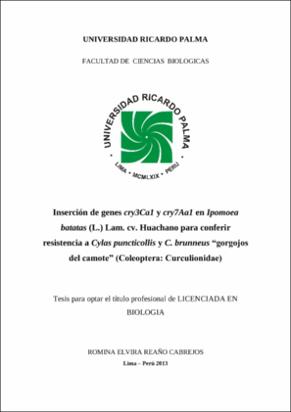Mostrar el registro sencillo del ítem
Inserción de genes cry3Ca1 y cry7Aa1 en Ipomoea batatas (L.) Lam. cv. Huachano para conferir resistencia a Cylas puncticollis y C. brunneus “gorgojos del camote” (Coleoptera: Curculionidae)
| dc.contributor.advisor | Quiñones Aguilar, Mauro | |
| dc.contributor.author | Reaño Cabrejos, Romina Elvira | |
| dc.date.accessioned | 2017-05-31T17:03:34Z | |
| dc.date.available | 2017-05-31T17:03:34Z | |
| dc.date.issued | 2013 | |
| dc.identifier.uri | https://hdl.handle.net/20.500.14138/915 | |
| dc.description.abstract | Con la finalidad de insertar los genes cry3Ca1 y cry7Aa1 en Ipomoea batatas (L.) Lam. cv. “Huachano” para conferir resistencia a Cylas puncticollis y C. brunneus “gorgojos del camote”, se desarrolló la transformación genética mediada por Agrobacterium tumefaciens, siguiendo dos protocolos de regeneración y transformación. Partiendo de 46 meristemos y 282 hojas con peciolo, se obtuvieron 8 eventos transgénicos de inserción completa del ADN - T (4 por cada protocolo de transformación) y un evento de inserción incompleta. Con una eficiencia de transformación de 8.70%, el protocolo a partir de meristemos demostró ser más eficaz en la obtención de eventos transgénicos de inserciones completas que el protocolo a partir de hojas con peciolo, con el cual se obtuvo una eficiencia de transformación de 1.42%. A su vez, los regenerantes fueron evaluados mediante pruebas in vitro (resistencia a kanamicina) y moleculares (PCR), con los análisis de PCR se confirmó que los 8 regenerantes callo positivos (resistentes a la prueba de kanamicina) también presentaron la inserción de los transgenes de interés “cry3Ca1 y cry7Aa1” y del gen marcador selector “nptII”. Asimismo, se determinó que 4 de los eventos transgénicos integraron secuencias externas al ADN - T “backbone” en el genoma de la planta, uno de los cuales, presentó la inserción del gen bacteriano “virD2”.With the purpose of inserting the genes cry3Ca1 and cry7Aa1 in Ipomoea batatas (L.) Lam. cv. "Huachano" to develop resistance to Cylas puncticollis and C. brunneus “sweet potato weevils”, the genetic transformation was developed using Agrobacterium tumefaciens, following two protocols of regeneration and transformation. Starting from 46 meristems and 282 leaves with petiole, 8 transgenic events were obtained with complete insertion of T - DNA (4 for each transformation protocol) and one event with incomplete insertion. With an efficiency of transformation of 8.70 %, the protocol of meristems proved to be more effective in obtaining transgenic events of complete inserts than the protocol of leaves with petiole, which obtained a efficiency of transformation of 1.42 %. The regenerants were evaluated by testing in vitro (resistance to kanamycin) and molecular (PCR), the PCR analysis confirmed that the 8 regenerants positive callus (resistant to kanamycin test) also presented the insertion of transgenes of interest “cry3Ca1 and cry7Aa1” and selection marker gene “nptII”. Likewise, 4 of the transgenic events integrated sequences outside the T - DNA “backbone” into the plant genome, one of whom, showed the insertion of the bacterial gene “virD2”. | es_ES |
| dc.description.sponsorship | Submitted by Wong Rafael (rafel_wl@hotmail.com) on 2017-05-31T17:03:34Z No. of bitstreams: 1 Reaño_re.pdf: 2203365 bytes, checksum: 0bca08aa8f096be080d94b5a4cb4d8c4 (MD5) | es_ES |
| dc.description.sponsorship | Made available in DSpace on 2017-05-31T17:03:34Z (GMT). No. of bitstreams: 1 Reaño_re.pdf: 2203365 bytes, checksum: 0bca08aa8f096be080d94b5a4cb4d8c4 (MD5) Previous issue date: 2013 | es_ES |
| dc.description.uri | Tesis | es_ES |
| dc.format | application/pdf | |
| dc.language.iso | spa | |
| dc.publisher | Universidad Ricardo Palma - URP | es_ES |
| dc.rights | info:eu-repo/semantics/openAccess | |
| dc.rights.uri | https://creativecommons.org/licenses/by-nc-nd/4.0/ | |
| dc.source | Repositorio Institucional - URP | es_ES |
| dc.subject | gorgojos del camote | es_ES |
| dc.subject | Huachano | es_ES |
| dc.subject | PCR | es_ES |
| dc.subject | ADN - T | es_ES |
| dc.subject | backbone | es_ES |
| dc.subject | sweet potato weevils | es_ES |
| dc.title | Inserción de genes cry3Ca1 y cry7Aa1 en Ipomoea batatas (L.) Lam. cv. Huachano para conferir resistencia a Cylas puncticollis y C. brunneus “gorgojos del camote” (Coleoptera: Curculionidae) | es_ES |
| dc.type | info:eu-repo/semantics/bachelorThesis | |
| thesis.degree.discipline | Biología | es_ES |
| thesis.degree.grantor | Universidad Ricardo Palma. Facultad de Ciencias Biológicas. Escuela Profesional de Biología | es_ES |
| thesis.degree.level | Título Profesional | es_ES |
| thesis.degree.name | Licenciada en Biología | es_ES |
| dc.publisher.country | PE | es_ES |
| renati.type | https://purl.org/pe-repo/renati/type#tesis | |
| renati.level | https://purl.org/pe-repo/renati/nivel#tituloProfesional | |
| renati.discipline | 511206 | |
| dc.type.version | info:eu-repo/semantics/publishedVersion |
Ficheros en el ítem
Este ítem aparece en la(s) siguiente(s) colección(ones)
-
Biología [176]


